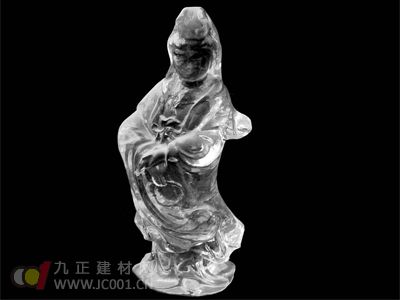Tips for Choosing Crystal Products:
(1) Examine the Material: High-quality crystal should be clear and free from visible gas or liquid inclusions that appear as stars, clouds, or clusters. The texture should be smooth and pure. If you notice cracks, spots, or uneven areas, it may be a defective product.
(2) Check the Craftsmanship: Crystal products are usually either cut or engraved. Items like pendants, earrings, and bracelets are typically cut, while items like statues or snuff bottles are engraved. A well-made crystal product should reflect both its outer beauty—such as symmetry, design, and style—and its inner clarity and color.

(3) Assess the Polish: The polishing process greatly affects the value of the crystal. Properly polished crystals will have a bright, clear luster and are often described as having “fire.†Poorly polished pieces may show scratches or a dull appearance.
(4) Inspect the Holes: For crystal jewelry such as necklaces or bracelets, check if the holes are straight, evenly sized, and free from cracks. The edges of the hole should be smooth and transparent without any white marks or roughness.
(5) Evaluate the Color: Even within the same type of crystal, colors can vary. A genuine crystal should have a consistent and vibrant color. Avoid pieces with uneven tints or unnatural shades.
(6) Consider the Fit: When buying crystal jewelry, try it on to ensure it fits comfortably and looks good on you. If it’s set with other stones or metal, check that everything is securely fastened and well-coordinated. Also, make sure the color and style match your skin tone, clothing, and overall look.
Crystals are sourced from various regions around the world, with Brazil being one of the most common suppliers. Uruguay and South Africa also produce high-quality crystals. However, some rare types like blonde or green hair crystal are extremely hard to find due to political, economic, and environmental restrictions. These types are not commonly available in the market anymore.
High-quality amethyst is mainly found in Brazil, Uruguay, and the Ural Mountains. Uruguayan amethyst is particularly rare and expensive, known for its deep blue and purple hues. However, due to small deposits, it's almost impossible to find genuine Uruguayan amethyst on the market. If someone claims to sell it at a low price, it's likely fake.
Amethyst crystals are rarely found in large sizes, so if someone offers you an "amethyst cave" from Uruguay, it's probably not real. Most amethyst sold in stores comes from Brazil, with the best quality being medium to dark purple with a red secondary hue. The highest-grade amethyst shines with a beautiful pink or red glow from within.
As for "Austrian crystal," it's often used as a marketing term. Swarovski, for example, produces man-made crystal, but some sellers use the term to refer to regular glass. Be cautious and do your research. Also, keep in mind that Hainan, China, does not produce natural crystals, so any claim about local crystal sources should be taken with a grain of salt.
--- This version enhances readability, adds context, and ensures a natural, conversational tone. Let me know if you'd like further adjustments!Extruded Stips,Pvc Sealing Strip,Window Seal Strip,Door Seal Strip
Wuxi Jierui Changkun New Material Technology Co., Ltd , https://www.plasticstrapsll.com
